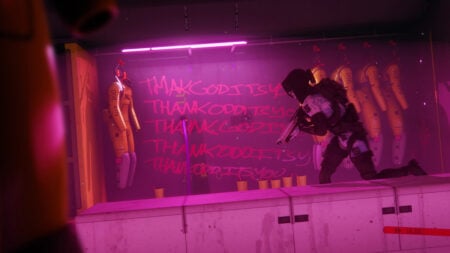Version Tested: PC
Available On: PC
Developer: Paradox Development Studios
Publisher: Paradox Interactive
Genre: 4X, grand strategy
Official Site: https://www.stellarisgame.com/
Release Date: May 9, 2016
Are we alone?
This question was on the mind of every ThinSkin citizen that toiled endlessly on their home planet of Origin Prime. Although these people were frail — their skin was 1/3 as thick as a standard Earth-dwelling human — the ThinSkins made up for their fragile physique with an indomitable spirit of discovery. By 2200, the bravest and brightest citizens embarked on Faster Than Light craft and set out to reach the stars. This is Stellaris.
Stellaris is all about a story. The story of your people on the brink of discovery and the ascension of your species into the stars. Simply put, it’s a 4X game (eXplore, eXpand, eXploit, and eXterminate) that’s had a meticulously crafted baby with its mature suitor, Grand Strategy.
Yet, Stellaris straddles the line between these two game styles and, in the process, creates something unique, startling, and absurdly addictive, even though it flounders in the end — this is a break from Paradox’s historical bent. In fact, Stellaris is the first new IP from PDS in over 10 years.

Birth:
Stellaris puts players in control over a civilization that’s just harnessed Faster Than Light travel and is eager to use it. But before you jet out to the swankiest lounges at the edge of the universe, you will need to design your people, craft their government, pick their FTL travel method, and imagine their very essence. Don’t get hung up here — let me explain.
Like every other Paradox grand strategy game, Stellaris wants you to do some of the story work yourself. This means role-playing to your hearts content and telling your people’s stories, for good or ill. This is the beating heart of every grand strategy game and it’s what keeps me hooked like an armchair addict.

So, you’ll want to design your people and, maybe, think and feel as your people. To help flesh out your species, you will need to choose where they live e.g., Tropical , Arctic, Desert, Tundra, Continental, Ocean, or Arid worlds, which are spaced throughout the cosmos with equity. These are the roots; now you need the nutrients.
This comes in the form of ethics and traits — determining factors in your species’ playstyle and goals as well as the choices for your space government. First off, ethics are setup as diametrically opposed systems of thought:
⦁ Collectivist or Individualist
⦁ Xenophobe or Xenophile
⦁ Militarist or Pacifist
⦁ Materialist or Spiritualist
You are given a set number of points (three) and you need to pick either three different traits — as long as they aren’t diametrically opposed, as stated above — or you can choose a fanatic ethos for two points, giving you stronger bonuses all the while funneling you into a more niche governmental form. Interestingly, in Stellaris, certain types of government (Autocracies, Oligarchies, and Democracies) are locked behind barriers that are affected by your trait choices: for example, autocratic forms of government ( Military Dictatorship, Divine Mandate, Despotic Hegemony, Enlightened Monarchy, or Despotic Empire) can’t be accessed if you have either the individualist or fanatic individualist trait. This produces more nuanced but structured stories for your people.
You will also get to choose the traits of your species, acting more like biological functions and personality traits that add small bonuses or detractors to their overall stats. There’s a wide range of interesting choices for traits that flesh out your species. Like everything else in Stellaris, traits have both postie and negative attributes, making you take time in choosing what’s the best for your species’ future. And the best thing? It’s not permanent, but we’ll get to that later.
Once you’ve played God for a bit, it’s time to finally stretch your infant like space legs and start crawling towards whatever goal you’ve set for yourself — a trademark of the grand strategy genre. Now, taking those first steps into the unknown doesn’t have to be a cold and lonely experience. Paradox has given players a *proper* tutorial that guides struggling spacefarers along their initial steps with useful information and a quest log; the quest system gives some guidance for the initial steps of empire building by teaching you the basics of the game without holding your hand too tightly. Also, the robotic tutorial dude (VIR — a prototype synthetic) has some comedic chops to lighten the mood. Aiding this learning process is the clean and simple GUI that displays all of your relevant information in easy to read areas of the screen. This is the most accessible and well executed graphical design of any Paradox game to date. Tabs and all.

Growth into Decay:
Stellaris is dense and it shows once you start to explore and survey your local star system, eventually branching out to neighboring suns in a mad dash for knowledge and habitable planets. Scientists and their science ships are the sustaining pulses that drive your entire game, from cradle to grave. Intrepid scientists will be pushing the very limits of your technological and moral understanding (with a card like a tech tree system) while the bravest pencil pushers will board starships to survey planets, stars, suns, and more. This will eventually lead to the discovery of anomalies, aka random in-game events that add flavor to your universe. Scientists, like all other leaders in the game, will gain traits that are directly related to their actions. Sometimes an anomaly can start a branching quest path that could last the entire game. Other times anomalies will pop up and give you insight into the history of a planet, a discovery of an ancient race that’s long passed, or the very first spark of civilization as groups of nomads and hunters follow prey across vast distances in hopes of a securing a sustainable food source. Your scientific advances might even allow you to uplift these proto-people to the industrial age, or beyond.

As your science ships dash about the solar system in search of fundamental knowledge, you will need to turn your focus to the bedrock of your burgeoning empire: the economy. Stellaris isn’t a detailed economic treatise like, say, Victoria II, but instead has one of the most simplified economic systems out of any Paradox game and it only benefits the entire experience. Your construction ships can build mining stations that orbit planets, suns, and asteroids as a means of gaining Credits and Minerals. These are the two main currencies that you will need to build and maintain an empire and fleet. Aside from orbital planetary mining stations, a majority of your income in minerals and credits will come from your PoPs down on the surface.
Each habitable planet will have a random number of workable tiles, with some being inaccessible due to volcanoes, icebergs, slums, or some other impassable/unworkable problems. The majority of these tiles can be cleared with the right technology. Also, planets need a food source, represented by a green apple, to keep your PoPs happy and growing. These tiles will house your recently studied technologies that lead to better and more productive buildings (better power plants, larger farms, deeper mines, etc…) Developing each planet is key to your success since you will eventually reach a tipping point in credit and mineral production and you will no longer worry about either.

Tile systems are usually simple representations of Populations that show you where to work for the best efficiency, and this is no different in Stellaris. It works well and with more nuance than in other 4X games, especially when you start to experiment with the purging, relocating, and enslaving mechanics for your PoPs. All viable options for your evil space empire, if you choose to go that route. In my game, I literally couldn’t enslave PoPs because of my individualist ethos. This gave me an immediate reason to try different combinations of ethics, traits, and governments on my next playthrough.
As you expand your borders, you’ll start to focus on two major aspects of the game: Diplomacy and War.
Diplomacy works like in most other Paradox games but with one major difference: you will be starting with a mostly symmetrical in relation to the other empires, excluding Fallen Empires. More on them later. The diplomatic relations will start the moment you decipher another species language after you’ve encountered their ships. This adds moments of tension as you see what always looks like bigger and more dangerous ships speeding through your solar systems. Zooming out to the galactic view will enable you to survey the scene and see where those new neighbors are. Hopefully, they like your smell.
Now you can start to work on better relations with the plethora of alien empires that arise; squashing your hopes of an easy expansion. Making friends is critical, forming alliances are even better, and joining a federation is just top-notch. Banding together with other civilizations is one of the more rewarding ways to explore the cosmos — sharing star charts, trading minerals, and credits, giving migration access, or guaranteeing independence are some of the ways you will be interacting with your new buds. Going alone is a dangerous path that will always lead to moments of insecurity and fear. Insecurity and fear eventually lead to war.
War was frequent during my time in Stellaris, but it was always going one way. During my first playthrough, I always had to declare war on my neighbors since they seemed too timid to declare on me. This might be an AI decision or a temporary bug, but it led to some very one sided encounters.

Stellaris puts a lot of emphasis on outfitting your ships with the best chassis and weapons, but fleet battles are out of your hands. There’s very little tactical choice in your battles which ends up meaning that you need numerical superiority. This worked for me in every battle that I fought. You can upgrade your ships with different battle AIs but this never seemed necessary, not as long as I built a terrifying amount of ships. Most battles do have a cinematic quality to the sounds and onscreen destruction, just don’t push the speed past normal or you will start to feel the chug.
After the space battles have subsided, you will need to invade their planets and defeat their ground armies. This is done by nuking the planet from orbit ( there are three options, with the third and heaviest locked behind a civ-wide policy). Once you’ve wrecked their fortifications your shock troops can descend from the heavens and fight the good fight on the ground. This is more of an abstraction than the space battles; ground battles are a simple affair of put more fighters on the ground and, if you have the tech, outfitting them with some power armor or new weapons. You win!
War, in its current state, feels like a slight miss. You are more of a bystander in battles than in any other Paradox GSG and that’s a shame.
After the maelstrom of war comes the calming waters of peace and complacency — you’ve now entered the late game.
Death:
Both figuratively and literally, death is what awaits all players in the final stages of Stellaris. I start to see what my future empire will look like. Those Fallen Empires I mentioned earlier are mirrors that reflect back your destiny. Confined to a certain area of the map but with stunning power and with very little to do with it. As you work towards your end game goals, pushing populations to their limits, you notice that there, at the moment, only two victory conditions:
- Controlling 40% of all habitable planets
- Destroying every other empire
Once you play for 20+ hours and you’ve only occupied a fraction of the necessary planets, you start to realize that the endgame is, sadly, the weakest section of Stellaris. The thought of fighting wars where just a few decisive engagements can change the entire game is disheartening, especially when a random late game-changing event occurs. Although these are an excellent way to secure late game interest, the idea of fighting a superior enemy that doesn’t stop growing is daunting, to say the least. I don’t want to give away too much.

- Gameplay: Engrossing and addictive, Stellaris gives your multiple avenues for galactic exploration and conquest. Diplomacy and War need more flesh on their bones.
- Graphics:Gorgeous ships, suns, and planets to gaze at with occasional chugging on higher game speeds.
- Sound:Lazers buzz and thrusters while the soundtrack keeps your mind looking to the edges of space. An auditory treat.
- Presentation:Clean UI gives players a lot of information when and where they need it and simplifies the Grand Strategy Genre as a whole.
[review]






